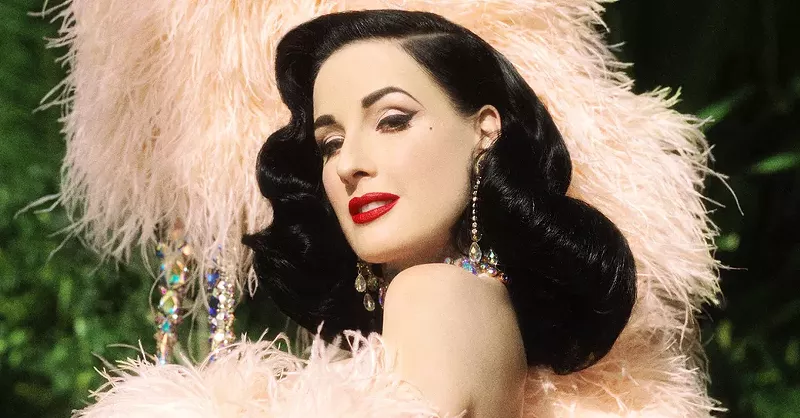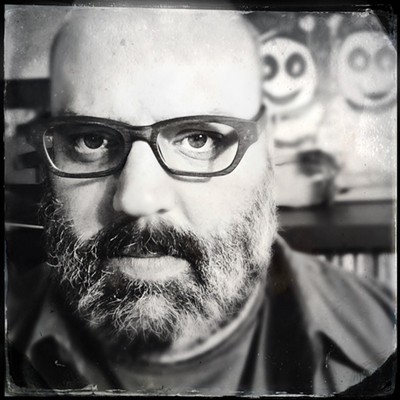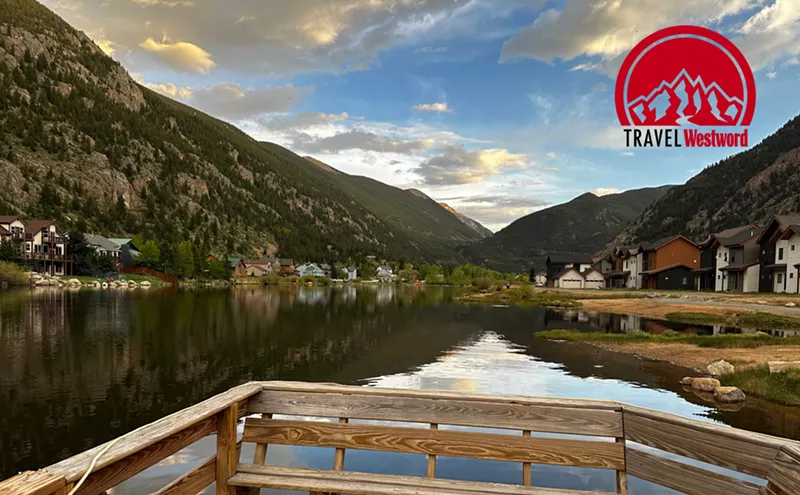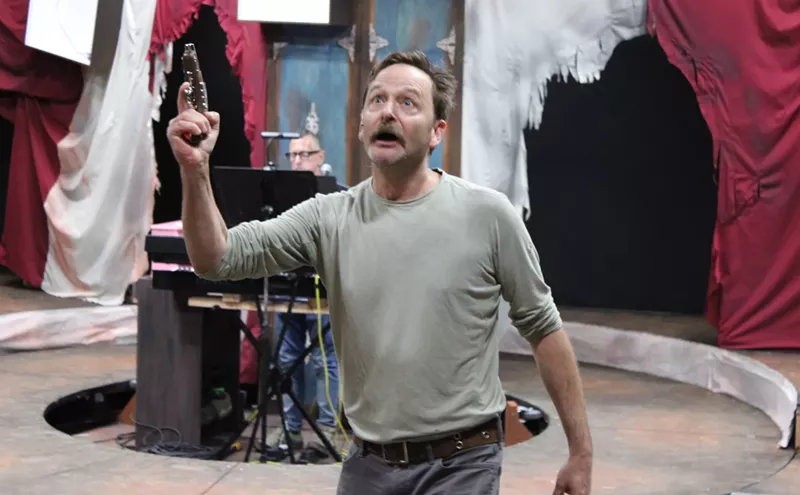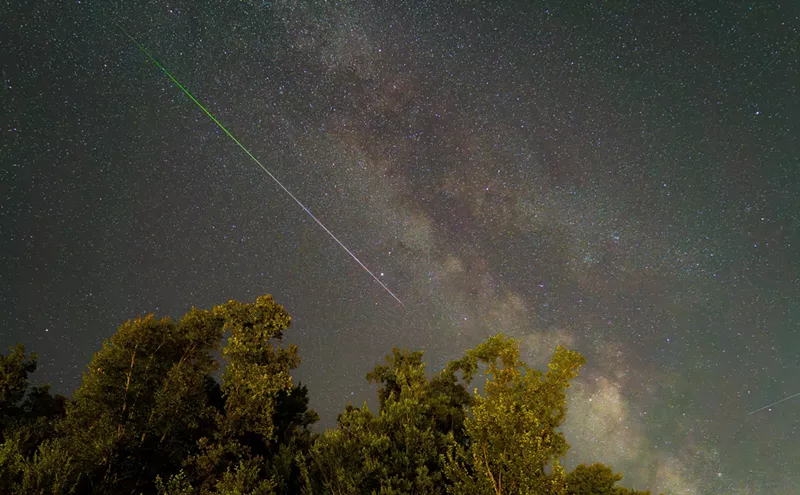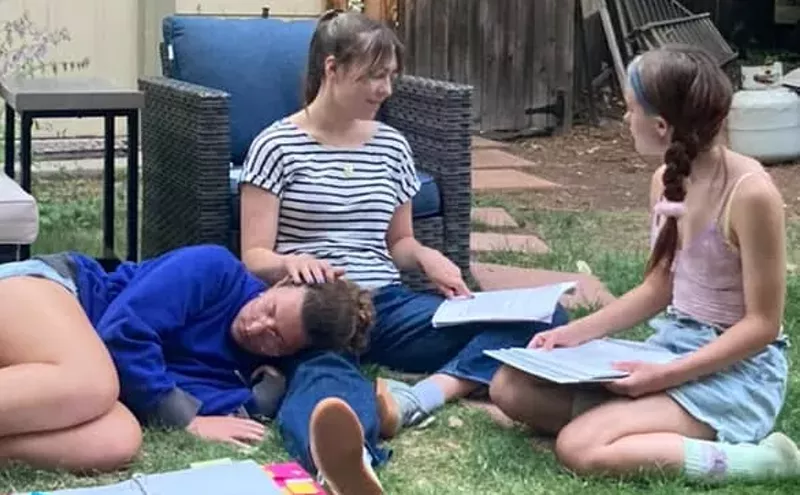Dita Von Teese grew up in a Michigan farming town as Heather Sweet, "just kind of a mediocre-looking girl," she says, before she moved to Los Angeles and eventually revolutionized the burlesque world. Von Teese and the Copper Coupe Burlesque bring their latest burlesque show, the most lavish yet, to the Fillmore Auditorium on Tuesday, June 12. In advance of that performance, we spoke with Von Teese about how her shows have evolved over the years, where she finds her cast members, and the new, self-titled album that she made with French artist Sébastien Tellier.
Westword: Looking back at your shows over the last few decades, how have they evolved?
Dita Von Teese: A lot. The production has evolved a lot since my early years of making little striptease acts. I’ve always sought to one-up myself every time I build a new act, so I think the current show is a product of twenty years of evolving it to a place that has never been seen in burlesque before. So, it’s very exciting, and this show has a lot of burlesque firsts in it, so I can’t wait for people to see it.
Can you give some examples of some of the firsts?
In this new show I have a number that features the entire cast, which we’ve never really done before. It has all new costumes. One of them in particular, I’m very excited about. It’s definitely the most decadent display of Swarovski crystal I’ve ever seen, and I’m kind of known for wearing those kinds of costumes. This one is more extravagant than the others. I can’t wait for people to see it under the lights. It has an innovative new crystal that has deeper facets that Swarovski has come out with, so we’re excited to see that on stage.
How many people are in your show?
We have seven cast members, and we’ve got the same number of crew. We’ve got an equal number of boys and girls, so we do not discriminate. We have a diverse cast that I’m very proud of. The very best of burlesque brought in from all over the world. We have people from Puerto Rico and Chicago and Poland and Australia. All over, really.
How did you find the people for your cast?
I’m always watching what’s going on in burlesque. I have a few different trusted sources that I say, “Who should I watch right now?" There’s actually a big burlesque competition that happens every year in Vegas, and people compete for this crown. I always like to see who’s competing in that and watch the videos afterward and see who I should sit down with and interview and see if they’re the kind of person that would fit into our touring family. But I just look for showstopping acts that take burlesque to the next level, modernize it and make it relevant. I’m not interested in copycat burlesque acts that are just mimicking the 1940s. Our show is very, very modern and exciting, and there has to be a touch of humor in every act, and we really love to have performers that can inspire others, as well.
How many acts do you have in the show?
I personally have four big production numbers, and like I said, I have a cast of seven. I have male backup dancers and the other shows are different performers that I think I really represent different facets of the burlesque movement. Everyone represents something else, something that I think is aspirational to people, because I never wanted to make a show of just pinup girls on stage. I wanted to show the strongest performers and people with really great personalities that come though on stage and change people’s minds about what it is to be a burlesque dancer.
You talked earlier about how with each show you try to take it to the next level. Is it a challenge sometimes to think of something one level higher than the last one?
The only challenge is usually the obstacle of money [laughs]. I’m my own producer, so I have to think of that. A lot of times I’ll have a really great idea, and you’re like, “Oh, yeah," or it will be something that you’re not allowed to do. There are a lot of rules in place in theaters of what you can and can’t do. I think it’s not difficult to keep within the spirit of the kind of burlesque that I love, like classic acts with a modern twist. But there can be some roadblocks sometimes, like, for instance, the show that I did at the Crazy Horse in Paris, which is a theater that holds about 250. We just used this amazing light projection technology, but that won’t work in a theater like the venues we do in America. It just doesn’t work if you’re not sitting right in front of it, but I love things like that. We have to think about what fits in the theater as well, and works in a big room, a big, historic theater.
Burlesque is typically in more intimate venues. Do you take that into consideration if you’re trying to have more of an intimate feel in a bigger room?
We love the energy of a bigger room, and I love the way it’s sort of a nod to the burlesque heyday, which was in the ’30s and ’40s, when burlesque was held in these big theaters. That’s one reason we like that, but I also love the small theaters where you can see every detail. We just like to strike a balance where people can still see the details of the costumes and the expressions on the performers’ faces, but you still get that energy of a big room.
You’ve talked in the past about how your audience is made up of about 80 percent women. Is that still the case these days?
For sure, more than ever. One thing you find a lot: It’s usually the woman’s idea to go to the show, and she’s dragging her husband or boyfriend along. We love that. I love that burlesque has become kind of an unlikely place for an alternative feminist movement. A lot of women are finding inspiration in going to a show like this.
When you were younger and you dyed your hair black, was that kind of like a switch flipping? Would you say that was the first step to kind of reinventing yourself?
Yeah. I found my confidence, really, in all the ways that I played with glamour in my early years. I’m a dishwater blonde from a farming town in Michigan and just kind of a mediocre-looking girl. I found that when I played with makeup and beauty and looked to the 1940s for inspiration, I felt like I could become glamorous, and that gave me confidence. I found a power in that.
How old were you when you started doing that?
I was probably in high school when I started wearing my thick black eyeliner and playing with the red lips. But when I graduated from high school, that’s when I really felt free to do whatever I wanted. I became involved with the club-kids scene in Los Angeles. I started hanging out with all the drag queens and go-go dancers and club kids. That’s when I really started having fun with my style.
Do you think your on-stage persona differs from your off-stage persona?
I don’t think so. I think that I discovered that retaining my personality and letting people see me and letting people see both the glamorous image I created and also seeing that glimpse of Heather Sweet from Michigan — all of that was important to my performance. I never really made an alter ego as far who I am as a person. I just liked playing with the aesthetics. So, that’s really it.
With your new album, Sébastien Tellier just wrote it with you in mind, right?
Yeah, I invited him to one of my shows in Paris, and then two years later I got an email from his record label that he wrote a whole record for me, and would I sing on it? I was a little reluctant at first, because I’m not a singer, but like with everything, I just thought it’s fun to embark on a challenge. And if he believed in me, I figured I had to give it a shot.
I read that you’re not very comfortable singing, but could you see yourself touring and just singing?
I thought about it a little bit. Sébastien and his people have been trying to talk to me about it, like. "We’ll rehearse, and we’ll make it so you sing the parts that you can sing and the other parts you can lip-sync.” At first, I was like, “I don’t know,” and then I thought, “Hey, everyone is out there lip-syncing certain parts of their music, except maybe Beyoncé. I thought, "Why not?” I thought about how I can sort of create the visual shows that I’m known for and incorporate the music into it. And actually, one of the acts that I’m doing in Denver does feature the music. It’s a very modern number, and we use one of the remixes for the act. It’s really exciting, just from the big-band striptease music to something like this. It’s a lot of fun. People are loving it.
Dita Von Teese and the Copper Coupe Burlesque, 7:30 p.m.Tuesday, June 12, at the Fillmore Auditorium. Tickets are $39.50; call 303-837-0360 for more information.

Audio By Carbonatix
[
{
"name": "GPT - Billboard - Slot Inline - Content - Labeled - No Desktop",
"component": "23668565",
"insertPoint": "2",
"requiredCountToDisplay": "2"
},{
"name": "STN Player - Float - Mobile Only ",
"component": "23853568",
"insertPoint": "2",
"requiredCountToDisplay": "2"
},{
"name": "Editor Picks",
"component": "17242653",
"insertPoint": "4",
"requiredCountToDisplay": "1"
},{
"name": "Inline Links",
"component": "18838239",
"insertPoint": "8th",
"startingPoint": 8,
"requiredCountToDisplay": "7",
"maxInsertions": 25
},{
"name": "GPT - 2x Rectangles Desktop, Tower on Mobile - Labeled",
"component": "24956856",
"insertPoint": "8th",
"startingPoint": 8,
"requiredCountToDisplay": "7",
"maxInsertions": 25
},{
"name": "Inline Links",
"component": "18838239",
"insertPoint": "8th",
"startingPoint": 12,
"requiredCountToDisplay": "11",
"maxInsertions": 25
},{
"name": "GPT - Leaderboard to Tower - Slot Auto-select - Labeled",
"component": "17676724",
"insertPoint": "8th",
"startingPoint": 12,
"requiredCountToDisplay": "11",
"maxInsertions": 25
}
]

